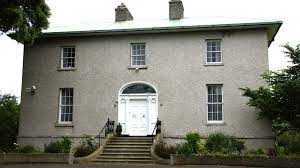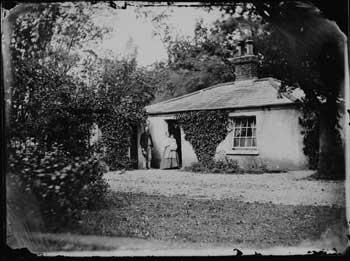In September 1956 Sr. Sheila Ferriter, (later Sr. Cora), Sr. Philomena, and I were assigned to the school in Coolock House which had been founded the previous year (1955) by Sr. Alonzo Manifold and Sr. Regina Assumpta Murphy. In September 1956, Sr. Regina Assumpta was assigned to our Mission in Kenya. The class number had increased from two to four. I taught in what is now the Community Room. Sr. Sheila was next door in what is now the Parlour and there was a sliding door between us. Sr. Margaret was upstairs and Sr. Alonzo, our Principal was in the “Chapel”. Our Lunch Room was also upstairs. The Carroll’s, who were caretakers lived in the basement where the McAuley Centre is now situated. The Dual Carriageway hadn’t yet been built and the gate lodge and Summer house from Mother McAuley’s time was still standing.
Every morning, we left Carysfort, Blackrock, at 8.30 and were driven to Coolock by James in a black Morris Minor. Sr. Alonzo was a most inspirational teacher and Principal. She was, in fact, an educator way before her time. She was quite a genius. She composed and produced musicals and managed to provide the necessary costumes at a time when money was thar a bheith scarce. Her pupils were fluent Irish speakers and very confident without being arrogant. She had trained them to work in groups. This they did without any fuss whenever she was called away, which could happen unexpectedly because not only was she Principal, but she was trying to establish a new school. They were like little Michelangelos at Art class with their smocks, easels and long brushes. I was in awe. She ordered magazines on Child Education from England and shared them with us. She personified the difference between mere teaching and education. She had a profound influence on me. I have been and am deeply indebted to her. In May 1957, our Postulancy finished and Srs. Sheila Ferriter, Margaret and I left Coolock School and began our Spiritual Year in Carysfort.
In May 1958, I was sent back to Coolock. The black Morris Minor had been replaced by a minibus as the number of Sisters had grown to meet the increased school enrolment. I was assigned to 2nd class (probably replacing some Sister going on Spiritual Year.) I was now teaching in Greenfield House, across what is now the dual carriageway. The houses on Chanel Road were later built on the land of Greenfield House.
I was Principal in Mercy College, Coolock from 1975 – 1984. One morning, recently, I woke up thinking of Mercy College. The image that came to me immediately was of Art, Music and Roses. I was delighted to dwell on this most life-enhancing memory. But, Ní gá a rá, it wasn’t all Art, Music and Roses. Stage 4 of the Building was just commencing. So, for the next year it was a case of contending with the architect, builder, painters, plumbers, bulldozers shortage of classrooms and general organised chaos. As the work neared completion, it was obvious that the Grant money was precariously low. We were going to be left with unpainted walls and grey lino-type flooring. The thought of being surrounded with unbroken greyness was not too exciting, so I approached our Mother General, and told her my story. She very generously agreed to finance the cost of paint for the walls and covering for the floors.
 Coolock House
Coolock House
There were five Sisters on the Staff. Srs. Eugenio, Maria, Nuala, Pauline, Therése and myself. Sr. Rose replaced Sr. Eugenio, in 1976. I cannot remember how many lay teachers were on the staff at that point, but when I was leaving in 1984 there were 69 between full-time and part-time and we always had two faithful cleaning women and a gardener on call. The school was called Virgo Clemens College. I felt that the name was a bit out of touch, as most people didn’t know Latin at the time. Then I heard our pupils being called the “Veergoes” and when I saw “the Veergoes” daubed across the body of a bus I decided the time had come to change to a more understandable title. Initially, there was resistance from pupils and staff, but eventually, “Mercy College” was accepted.
When I look back, I am astonished at all that was accomplished. We had a very talented and committed staff. I remember 4 Musicals we did in my time, the first was “The Children of Lir” composed by a teacher in Chanel College, and produced in cooperation with the pupils of Chanel College. Then, we decided to go it alone and to involve only (but, all) 5th Year pupils. We enjoyed excellent performances of “HMS Pinafore”, “The Pirates of Penzance” and “Oklahoma”. Every Christmas all Year-groups were involved in a Carol Service and tickets were sold to parents and friends. The proceeds went to Concern Worldwide. The girls exercised great imagination in thinking up ways of making additional money for Concern. One year they managed to get a Gym Horse and to equip themselves with Charlie Haughey’s riding boots, hat and riding crop. They charged for rides on the horse and collected a sizeable amount of money for the Third World.
We had an extraordinarily vibrant Art Department. A number of pupils went on to the College of Art and one year we qualified for the Texaco Art Competition. We didn’t win but enjoyed a trip to Cork for the Finals at the expense of Texaco.
I recall a few innovations we undertook during my time as Principal. For example, the English and Religion Departments introduced “team teaching” at senior level, which proved very interesting for teachers and pupils. We also set up a Home School Liaison Service in the late 1970’s, involving some of our retired Sisters, long before the Department of Education thought fit to do so. Then there was our Personal Development and Broader Education Programme with a range of topics, including personal understanding, healthy living, politics, feminism. We put it in as English on the Timetable Analysis as the Department refused to sanction it. In the early 1980’s we introduced a Pastoral Care programme.
We were allotted one Career Guidance teacher by the Department of Education, but this was in no way adequate for our numbers 700+, so again the Congregation agreed to provide funding for part-time teachers, thus leaving a position free for a second Career Guidance Counsellor. We also got a Chaplaincy team together. We had priests assigned to us from Coolock, Artane and Bonnybrook, as our pupils came to us from several parishes.
As Mercy Principals in the Dublin area, we had no experience of larger Post Primary schools, so we visited a number of schools in England – the London area – to get ideas about specialist rooms and general school management. Later, some of us went to Surrey to study school management and educational development in large mixed-intake schools. Then, when Remedial and Special Education were being introduced to the Secondary School system, here, we went to Scotland and met with Officials in the Department of Education who were most helpful. They organised Meetings for us in Glasgow and Edinburgh.
The concept of Pastoral Care in schools began to emerge in the early 1980’s. This was new to us in Ireland. Courses were being offered in Swansea University so, again a number of us attended one of these in the Summer Holidays, and came home enthused.
Of course, while all these programmes were getting off the ground our staff were labouring away with the daily grind. Our gardener, too, landscaped the grounds, planted a number of rose bushes, an array of heathers, junipers and ever-green miniatures on the bank in front of the school.
At the end of 1983 I felt the need to move on. A lot of development was still necessary especially in the PE and Games department. I hadn’t the energy to embark on this. I also felt a call to work as Chaplain/Counsellor in Mercy College. I asked if I might take a Sabbatical. I was accepted on a Certificate in Theological Studies Programme in Berkeley, California. I never got back to Mercy College.
During my years in Mercy College I lived happily in Coolock Convent.
Patricia Finucane rsm
South Central Province




